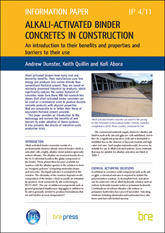
Alkali-activated binder concretes in construction- An introduction to their benefits and properties and barriers to their use Downloadable Version
Alkali-activated binders have many cost and durability benefits. Their manufacture uses less energy and produces less carbon dioxide than conventional Portland cement. They are based on minimally processed industrial by-products, which significantly reduces the carbon footprint of concretes made from them. BRE-led research has shown that alkali-activated binder concretes can be used on a commercial scale to produce durable concrete products with physical properties that are comparable to or better than those of equivalent Portland cement concrete. This paper provides an introduction to the technology and reviews the benefits of and barriers to wider adoption of these systems. It also presents the results of industrial-scale production trials.
Contents
Introduction
Chemical activating solutions
Mixture design, production and curing
Engineering properties
- Effects of temperature on strength development
Chemical and physical durability
Life-cycle analysis and environmental impact
Construction applications
Barriers overcome and remaining barriers
Standards and regulatory framework
Industrial trials
Environmental benefits of trial products
Current limitations of alkali-activated binder concretes
Future developments
References and further reading
Frequently asked questions about alkali-activated binder concrete
